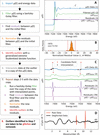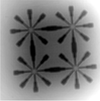issue contents
July 2021 issue

Cover illustration: Elemental maps of V, Ti, Cr and Mn normalized by the incoming photons flux, used in the paper by Marini, Roqué-Rosell, Campeny, Toutounchiavval and Simonelli (pages 1245–1252) where MAP2XANES is deployed to define the Mn species distribution on a natural sample of hausmannite.
facility information
research papers
The diaboloidal mirror is a reflecting surface that converts a spherical wave to a cylindrical wave (or vice versa). Application of the mirror in a collimated two-crystal monochromator will be the main application area and will allow brightness preserving focusing, even with the very small source size of a multi-bend achromat ultra-high-brightness synchrotron source. An exact analytical solution for the surface shape of a diaboloidal mirror as a function of the conjugate parameters of the mirror placed in a beamline is presented.
The diaboloid mirror is a surface that converts a spherical wave to a cylindrical wave. It finds application in bending-magnet beamlines at low-emittance storage rings, such as ALS-U. Here, diaboloid mirrors are modeled and the benefit of using this type of mirror is studied by ray tracing.
The propagation of the transverse electric modes in a plasma-filled waveguide with an elliptical cross-section is investigated, and the field components, the cut-off frequencies and the electron beam trajectory are calculated.
Open  access
access
 access
accessAn ultra-high-stability four-axis manipulator for use with soft X-ray beamlines, exhibiting eigen-frequencies in the 50 Hz region and a linear/angular positional accuracy below 100 nm/500 nrad, is described. Long-term positional stabilities of 20 nm/200 nrad are also demonstrated.
A photon-counting detector that employs microchannel plates combined with a quad Timepix readout is evaluated for soft X-ray imaging experiments conducted at synchrotron beamline facilities, where the time and position of each photon is registered by the detector. This work describes proof-of-principle experiments conducted with this technology where a spatial resolution of ∼6 µm is achieved with single-photon counting. Future developments of this technology for the possible extension of X-ray photon correlation spectroscopy analysis to sub-microsecond timescales are presented.
The imaging performance of a new micrometre-scale pixel direct conversion hybrid X-ray detector is reported. Characterization using hard X-ray energies up to 63 keV was performed using the synchrotron beamline 1-BM-B at the Advanced Photon Source of Argonne National Laboratory.
Open  access
access
 access
accessIt is shown how soft X-ray nanospectroscopy maps of powders (particle size ∼200 nm) can be analyzed to quantitatively retrieve X-ray linear dichroism (XLD) parameters. A computational modeling procedure is described that can be used in conjunction with Monte Carlo simulations to prove statistical dissimilarity of XLD parameters between different samples.
Presented is a 3D-microfabricated, 3D hydrodynamic focusing microfluidic mixer to study mixing-triggered reactions via X-ray spectroscopy. The 3D-microfabricated format of the device offers repeatable production. Meanwhile, the mixing scheme enables highly uniform sample residence times on the order of milliseconds.
The incorporated site of magnesium doped in gallium nitride has been identified by X-ray absorption spectroscopy using a superconducting tunnel junction array detector and spectrum simulations. In addition, the presence or absence of hydrogen around magnesium can be identified through distinctive characteristics expected from the spectrum simulations.
Zinc K-edge X-ray absorption near-edge structure (XANES) spectroscopy of Zn adsorbed (Znads) to quartz and amorphous silica [SiO2(am)] reflects coordination change and underlying surface disorder. XANES standards of Znads on silica are presented, including outer-sphere octahedral Znads on quartz, inner-sphere octahedral Znads on quartz, inner-sphere tetrahedral Znads on quartz, inner-sphere octahedral Znads on SiO2(am) and inner-sphere tetrahedral Znads on SiO2(am).
In order to set up the bases for extracting quantitative information from transition metal K-edge X-ray magnetic circular dichroism (XMCD) signals of coordination polymers, the effects of temperature and magnetic field on these signals are studied. A manual procedure for data treatment is also developed. Key points for transition metal K-edge XMCD measurements of coordination polymers on any XMCD-dedicated beamline are provided.
Open  access
access
 access
accessUsing the `deep image prior' characteristic of generative neural networks, a post-processing method that mitigates the inter-slice crosstalk issue in multislice ptychography has been developed. Under certain scenarios, crosstalk can be suppressed effectively in slice images reconstructed using ptychographic diffraction data alone.
Open  access
access
 access
accessThe influence of various experimental parameters on the quality of acquired time-resolved scanning transmission X-ray microscopy images determined by Monte Carlo simulations is investigated.
Open  access
access
 access
accessA quantitative analysis of the effect of strain on image reconstruction in Bragg coherent X-ray diffraction imaging and ptychography reveals reconstruction artifacts caused by the limited spatial resolution. With the modulus homogenization constraint applied, the reconstruction artifacts are efficiently removed and an Fe–Al alloy sample with strong strain that features π phase steps due to anti-phase domain boundaries is successfully reconstructed.
X-ray ptychography was applied to assess the masses of human cell nuclei using phase shift information. A modified ptychography algorithm that improves the quality of the reconstruction for weak scattering samples was applied to calculate the mass of several human nuclei.
Compton scattering imaging has been applied to coin batteries to obtain their cross-sectional images directly.
short communications
An algorithm has been developed for the automated deglitching of full X-ray absorption spectroscopy spectra.
beamlines
Open  access
access
 access
accessA resonant inelastic X-ray scattering (RIXS) spectrograph based upon Montel optics capable of energy resolutions better than 35 meV at the Ru L3-edge (2840 eV) has been constructed at beamline P01 of the PETRA III synchrotron.
The physics design, optics, experimental stations and recent results of the XRD-based engineering applications beamline, recently commissioned at Indus-2 synchrotron source, India, are presented. The beamline is now available for users.
The double-bounce high harmonics rejection mirrors (HHRMs) system has a key role in the design of the Taiwan Photon Source tender X-ray absorption spectroscopy beamline and will reduce the thermal load of downstream optics and benefit in cutting off the high-order harmonics. Double-bounce HHRMs in front of the collimating mirror and double-crystal monochromator could provide an optical design concept for a wide range of spectroscopic measurement requirements, particularly at synchrotron facilities with a high-current storage ring.
Open  access
access
 access
accessA new protein crystallography beamline (BL-11C) has been constructed at Pohang Light Source II. The BL-11C beamline allows routine protein-structure determinations under a robot sample-mounting system and room-temperature structure determinations through synchrotron serial crystallography experiments.
A multi-frame, X-ray diffraction (XRD) detector system has been developed for use in time-resolved XRD measurements during single-event experiments at the Dynamic Compression Sector at the Advanced Photon Source. The detector is capable of collecting four XRD patterns during an experiment, each from a single X-ray bunch. The temporal resolution and data post-processing procedures are discussed in detail.
Open  access
access
 access
accessA description of the photon beamline vacuum system of the European XFEL is given, together with experiences gained during the first years of operation.
Open  access
access
 access
accessThe development of instrumentation and software to support mail-in solution scattering is presented.
computer programs
MAP2XANES is a Jupyter interactive notebook for elemental mapping and XANES speciation.
Open  access
access
 access
accessContrast, a simple Python framework for controlling beamline experiments, is presented. Contrast can be easily adapted to any beamline, or serve as inspiration for constructing new, suitable tools tailored to individual instruments.
Open  access
access
 access
accessPyPhase is a free and open-source Python package for propagation-based near-field phase reconstructions, which implements some of the most popular phase-retrieval algorithms in a highly modular framework supporting the deployment on large-scale computing facilities. This makes integration, development of new phase-retrieval algorithms, and the deployment on different computing infrastructures straightforward.
A major upgrade of the synchrotron radiation calculation code SPECTRA is reported.


 journal menu
journal menu


















































